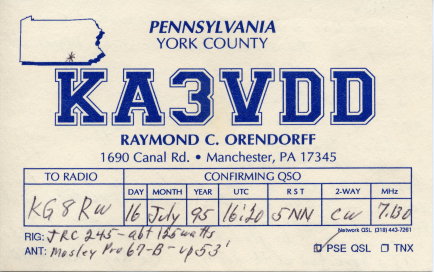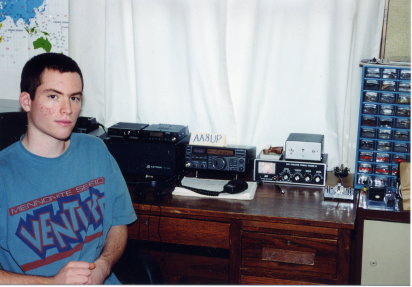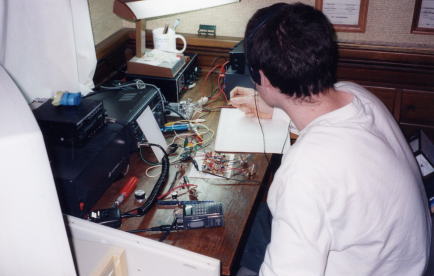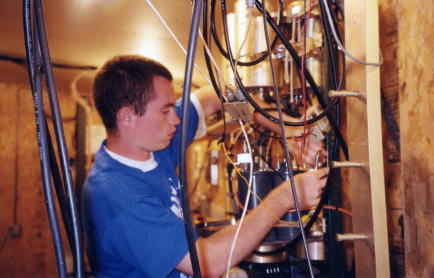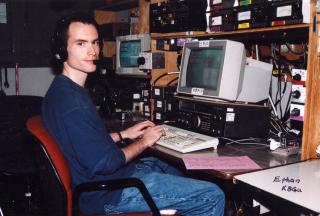Mom and Dad talked about getting a shortwave receiver for much of my childhood. I had never listened to one, but I was fascinated by the idea of worldwide communication. A friend of the family, Al, KD8KP, suggested ham radio instead. Not only would we have a general coverage shortwave receiver, we could also talk. They had thought about getting a cellular phone, which in the early 1990s was a novelty. Al assured them that they could use ham radio for local communications as well, without some of the problems associated with poor cell coverage. This sounded like a match. Furthermore, Al added, the FCC had just dropped the requirement to learn Morse code for a license. Dad eventually started studying the material for the “no-code Technician” class exam. After a few weeks, I took interest in that book he was reading every night.
Five of us from my hometown took the test in the Stark County (Ohio) Sheriff’s Office on a Saturday morning. Four of us passed: Tim, Doran, Me, and Dad. And thus began the interminable wait for our licenses. At that time, the FCC’s amateur licensing division was not fully computerized and it was reeling under pressure from the flood of new applicants brought on by the no-code license. As I like to say, I passed the test on the day after my last day of sixth grade and the license didn’t come until the week before I started seventh grade. What a way to spend your summer vacation! Hoping that the arrival of our licenses was imminent, the whole family went to Universal Radio near Columbus in July to go radio shopping. After much deliberation, we picked up a Yaesu FT-5200 VHF/UHF FM mobile radio for Dad and an Alinco DJ-580T VHF/UHF FM handheld for me. (I really had my eye on the TS-50S, but although Dad said they would consider getting it, it occurred to me that I couldn’t transmit with my no-code license.)
The licenses finally came in August. I still remember Dad going to get the mail on Saturday morning. Upon his return, he told me he had something I’d been waiting for. We were N8ZYK (me) and N8ZYL (him). We made our first QSO on 146.52 FM that day.
We had already discovered the local repeaters: 146.67 and 444.875. Soon, we became regulars. It’s hard being a kid in ham radio. I never felt fully included, except by a few of the guys on 444.875. Dad had a commuter roundtable on 442.075 that he enjoyed for a few years. But, despite running into other young guys KB8PPK and KB8PPJ (who I do not believe are still active), repeaters weren’t for me. “Real hams” worked DX, I supposed, and set about learning Morse code.
Unlike the theory and regulations, which came very easily to me, Morse code was a bear. I am chronically undisciplined and it shows when I try to do things that do not come easily. I just could not do it. I tried a number of strategies, including software (SuperMorse) and a HeathKit HR-10 I beg-borrowed from KE8XM. After failing it once, I redoubled my efforts at daily study and passed the 5-wpm exam in Coshocton in December 1994. But, I still did not have a radio. So, I did what seemed logical: I kept upgrading my license as I saved for a radio (Mom and Dad were not an unbridled source of cash for the hobby—the DJ-580T was an anomaly). In March 1995, I barely passed the 13-wpm Morse exam with 7/10 correct answers on the questionnaire (as opposed to the “purer” pass of 1-minute solid copy), and aced the General class written, which at the time was trivial. At most exam sessions, you could pay the exam fee once and keep taking exams until you failed one. I took the Advanced written at the same time as the General. Didn’t pass. Not even close.
In May, I took the Advanced written in Freemont, OH, which was near Dad’s family’s vacation home on Lake Erie. The examiners were astounded that a 14-year-old sat for the Advanced and passed. The Advanced theory was pretty in-depth, comparable to what is on today’s Extra. I took the 20-wpm Extra Morse code test there, too, and failed. My licensed arrived a month later with the new callsign KG8RW. I still didn’t get any respect on the repeater.
During the summer of 1995, we took a trip out West. Our itinerary sent us first to Denver by air, then we would drive around Colorado, New Mexico, Arizona, and Utah. At some point, I had purchased an NE602-based Ramsey 20-meter direct-conversion receiver kit to keep me in-tune with the HF world while I was saving for something bigger. I had surreptitiously stashed this receiver, as well as a wire dipole into my carry-on bag. When we went through the x-rays at Cleveland Hopkins, the screener said, “Sir, do you have a lot of wire in your bag?” I responded to the affirmative as Dad was scolding me thoroughly for bringing it. They waved us through. This was the first of many such encounters over the years.
I made my first HF CW contact in July 1995. Doran, N8ZYJ, had loaned me his HeathKit SB-303 and SB-401—built with his son, Dave, W9GR, in the late 1960s. After much fussing and tinkering, I was able to get the radios to operate together in transceive. The VFO in the SB-401 transmitter had a broken drive linkage. So, this was necessary. I had installed a G5RV antenna—what is so seductive about the G5RV for new hams?! It was about 20 feet up (yeah, I know this isn’t a good idea). Somehow, I managed to skip church (Mom was out of town) on a Sunday morning. I heard KA3VDD calling CQ on 40 meters and gave him a call back. The rest, as they say, is history. I was shaking. When Dad got home from church we went to Birdie’s (local restaurant) for lunch: I had a triple hamburger, tater tots, and a vanilla milkshake.
I passed the Extra written at the Warren Hamfest in August (and failed the 20-wpm code again). They had started giving the exams in Millersburg. So, I took the 20-wpm in Millersburg the following weekend and passed. I was granted AA8UP.
By the Fall of 1996, I had saved enough lawn-mowing money (that I hadn’t frittered away on other things like my computer habit) to buy a new Yaesu FT-840 HF radio. One of the great things (I thought) about the FT-840 was that I could operate SSB. The SB-401 had SSB, but I was unable to find a microphone that would connect to it. I made a bunch of SSB DX contacts with it, including a few in the CQ WW DX contest. But, 100 watts on SSB at solar minimum to a G5RV at 20 feet was like pulling teeth. One day, I was trolling for DX on 20 SSB. Finding nothing, I flipped to 20 CW and heard a UA1 calling CQ. I called him and he came right back. Wow. I became a CW DXer from then out.
I reasoned that contests would be a good way to build my DXCC total. And they were. But, I found that I liked CW contesting even better than DXing.
I had a lot of good experiences in those days. I worked for Electronic Devices Company (a two-way radio and security system shop) during the summer. The owner and technical staff were all hams (mostly the guys from the 444.875 repeater, which I maintained for KD8KP until he decided that his move to New Mexico was permanent). I operated Field Day a few times with the other local hams. When they saw me going at it on CW, some asked “Are you really copying that or is the computer doing it?” Others said, “You should talk to Goose. He and some other guys go all over the place, just to operate CW contests.” I should have called him right then and there, but I didn’t.
When I went off to college at Ohio Northern University, the first thing I noticed was that there was a ham radio station on campus. I went clamoring about to find out more. Nobody was using it. The professor who was in charge of it told me that he had a friend up in Findlay who routinely asked if there were any hams around. He put me in touch with Bill Kelsey, N8ET. Bill is a real ham’s ham. He is a homebrewer and a contester, a proficient CW operator and more. He even owns a ham business, Kanga US. I didn’t have a car on campus my freshman year. But, we managed to connect via e-mail until my sophomore year when I had a car. Bill is a member of the Findlay Radio Club, whose station W8FT has enough towers and antennas to make a lot of contesters drool. I had a good time operating W8FT and getting to know the Bills, N8ET, and AD8P. We operated SS and the ARRL 160. I did SOSB-15 in the ARRL DX once. The Bills were also members of the Mad River Radio Club (a contest-specific club) and encouraged me to join. I did. I got to visit some of the other big stations in the area, notably K8CC and K8AZ, as well as the one I should have five years earlier…
Goose, W8AV, is about 20 miles north of my home. What a station! I did CQ WW CW with him and his crew in 2001. I remember sitting next to Goose, me on 15 and him on 10 on Sunday morning, each of us pushing the other’s rate meter higher. Fun! One of the other fun things about operating W8AV is that he is an FOCer; and, all of the other FOC guys want more than just a report. For someone who had (and still has) a rather tenuous grip on conversational Morse code skills, that was an eye-opener! Goose runs Kenwood TS-930S transceivers—six of them. He told me how inexpensive they were and I started looking for one of my own. I bought my first contest-grade radio from K8RF in 2003—a TS-930S with the PIEXX board and four filters. That was a real boon. I could hear stuff I’d never heard before, although getting a CW filter for the FT-840 at Dayton in 2001 also helped. (That was the year that AD8P commented, “It sure is fun to go to Dayton with somebody who spends money!” I bought two CW filters, Pro-Set, and a bunch of random small goodies.)
I went to graduate school at the University of Minnesota in 2003. I joined the Minnesota Wireless Association immediately and put out a note on their e-mail reflector about looking for a place to contest since I was living in an apartment in Minneapolis. Paul Bittner, W0AIH, responded to my plea, introducing me to the biggest station I’d ever seen. With a bewildering array of antennas, it was hard to know which ones to use. But, eventually found my favorites. Fifteen meters is probably my favorite HF DX band and W0AIH has a couple of good 15-meter antennas. The best is a five-element Yagi at 180 feet. That one is a great band-opener and long-haul pile-up buster. I enjoyed getting to know a bunch of the guys in the MWA, also bringing some of the K8MR energy for mobiling in state QSO parties when N0YNT and I did the MnQP in 2004. I did it again in 2005 with K0SR. Both times we finished in second place. Not bad for a temporary lash-up in a Ford Escort. N0FP, K0TO, and I took an interest in building the W3NQN filters for SO2R operation.
In 2005, I got married and we moved to Urbana, IL. That was also the year that I bought the second TS-930S from K5RC. Being married and in graduate school left little time for radio, although I did get my priorities mixed-up from time to time and had a great time operating SS, NAQP, and the Sprints from home, as a member of the Society of Midwest Contesters. I also managed to operate from NO9Z a couple of times, mostly in the ARRL 160, which is another contest I enjoy immensely. Skills honed in ham radio transfered readily to my graduate research on the ionosphere. And, work travel gave back a little bit, too. I got to operate from Chile in 2006 and Curacao in 2009. KA6A had an office around the corner from me for a couple of years and he would always keep me updated on the DX world. So did K9AN, who was on my dissertation committee, although he’s not too active anymore. I spent a lot of time in K9BF’s office over in the Chemistry Department talking him into helping me with this or that.
In the Spring of 2009, as I was finishing up my degree, I managed to pick up a TS-700 2-meter all-mode radio on attractive terms via K9GY. This rekindled my interest in VHF+ weak signal operating. Inspired by W9SZ’s homebrew transverters, I set out to do the same for the other bands. But, I graduated and we (somewhat forcibly given the state of the economy at the time) moved to the Washington, DC, area in the Summer of 2009. I have spent most of the intervening time getting the station put back together and building transverters. After about nine months of living here, I finally made my second appearance at a Potomac Valley Radio Club meeting and became a member. I have a couple of invitations to visit local stations, on which I need to act…
